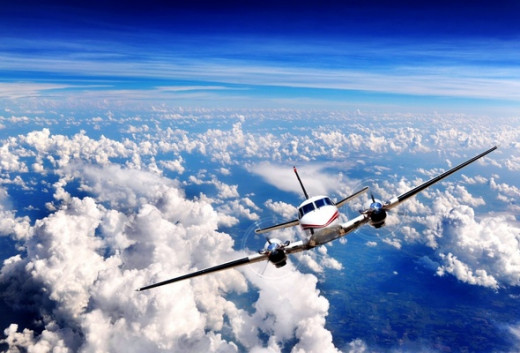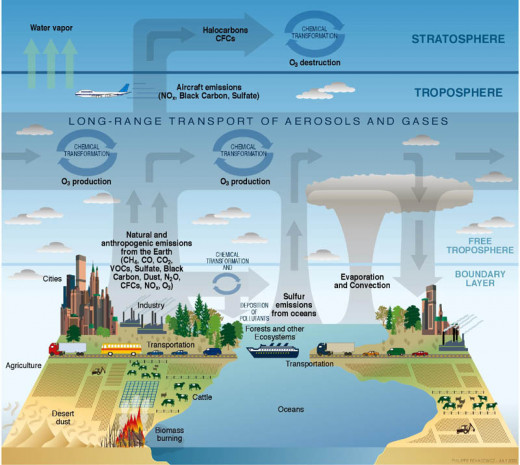Flying 101: The Atmosphere.

Ignoring the birds, aircraft, water in various forms and the complex air-bone garbage of civilization, the atmosphere consists of nitrogen (78%), oxygen (21%), carbon dioxide (0.003%), and smaller amounts of other gases. The three named gases are important to us physiologically. Due to the constant mixing of winds and other weather factors, the percentages given are nearly constant to 70,000 feet.
It clearly goes without saying that the atmosphere plays a huge role in flight, aviation and aeronautics. Knowing what it is composed of, analysing, studying and understanding its characteristics is vital to the avid flyer or aviation enthusiast.
The atmosphere with which we are concerned in this series, is divided into three parts; the troposhpere (uppper limit 28,000-55,000 feet), the tropopause, and the stratosphere (upper limit 45,000-25,000 feet). The ionosphere which is above 250,000 feet is of no immediate interest to us in this article.
The stratosphere extends from the earth's surface to an average height of 35,000 feet and is characterized by a varying moisture, turbulence, a nearly constant rate of temperature decrease with altitude, and prevailing westerly winds.
The tropopause is the narrow transition zone between the troposphere and the stratosphere; its height varies with the latitude and the seasons. It is higher in summer than winter and higher at the equator than over the poles. The tropopause, having some of the characteristsics of the lower zone, offers a onvinient excuse for that "bumpy" flight above 30,000 feet especially with older/smaller models of aeroplanes.
The stratosphere is characterized by constant temperature, high velocity winds (jet stream - also found in the upper topopause), and an almost complete lack of moisture and weather phenomena. The speed of sound, being directly proportional to the square root of the absolute temperature, remains constant throughout the stratosphere (662 mph).

In the lower zones, atmospheric temperature decreases rather steadily with increase in altitude. While local air masses and geography influence the temperature lapse rate, it can be generally stated that there is a 3-4 degree (Fahrenheit) or 2 degree (Celsius) loss per 1,000 feet. Thus, the following average ambient temperatures can be expected at these altitudes:
Altitude
| Temperature
|
|---|---|
Sea Level
| 59 ° F
|
5,000 ft.
| 41° F
|
10,000 ft.
| 23° F
|
15,000 ft.
| 5° F
|
20,000 ft.
| -12° F
|
25,000 ft.
| -30° F
|
30,000 ft.
| -48° F
|
35,000 ft.
| -67° F
|
Above 35,000 feet the stratosphere temperature remains fairly constant at -67 degrees Fahrenheit (-55 degrees Celsius.)
Pressure also decreases with altitude but logarithmically rather than arithmetically as does temperature. Sea level pressure is usually considered to be 14.7 psi (pounds per square inch). 29.92 in Hg. (inches of mercury - atlimeter setting), or 760 mm Hg. (millimetres of mercury). At approximately every 53,000 feet the decimal point of pressure moves left one digit.
Sea Level - 760 mm Hg.
53,000 feet - 76 mm Hg.
106,000 feet - 7mm Hg.
And so on, and so forth..
A more useful table, showing pressure change at corresponding altitudes and their ratios, is given below (rounded values)
Altitude
| Pressure
| Ratio
|
|---|---|---|
Sea Level
| 760 mm Hg. - 14.7 psi
| 1 atmosphere
|
5,000 ft.
| 633 mm Hg. - 12.2 psi
| |
10,000 ft.
| 522 mm Hg. - 10.1 psi
| |
15,000 ft.
| 429 mm Hg. - 08.3 psi
| |
18,000 ft.
| 380 mm Hg. - 07.3 psi
| 1/2 atmosphere
|
20,000 ft.
| 350 mm Hg. - 06.7 psi
| |
25,000 ft.
| 282 mm Hg. - 05.5 psi
| |
27,000 ft.
| 252 mm Hg. - 04.9 psi
| 1/3 atmosphere
|
30,000ft.
| 226 mm Hg. - 04.4 psi
| |
33,000 ft.
| 196 mm Hg. - 03.8 psi
| |
35,000 ft.
| 179 mm Hg. - 03.5 psi
| 1/4 atmosphere
|
40,000 ft.
| 141 mm Hg. - 02.7 psi
|
The total pressure of the atmosphere at any altitude is the sum of the partial pressures of the individual gases found in the atmospheric gas mixture. The sea level pressure of 760 mm Hg., for example, is the sum of the partial pressures of nitrogen, oxygen and the other rarer gases.
Gas
| Partial Pressure
| Percentage of Atmosphere (Constant composition to 70,000 feet)
|
|---|---|---|
Nitrogen
| 593 mm Hg.
| 78%
|
Oxygen
| 160 mm Hg.
| 21%
|
Other gases
| 7 mm Hg.
| 1%
|
Total atmoshpere
| 760 mm Hg.
| 100%
|
The oxygen partial pressure, at any altitude up to 70,000 feet, equals 21% of the total pressure at that altitude. For example, the oxygen partial pressure at 10,000 feet equals 21% of 522 mm Hg., or 110 mm Hg. Throughout the remainder of this series of articles we will be concerned with the partial pressures of specific gases in the atmosphere, particularly oxygen. From the physiological standpoint it is the partial pressure of each gas that governs its effect in the body, not the percentage of the gas in the total mixture.
Alright, now you know a little bit about how the atmosphere works and how it varies in relation to altitude and temperature and most importantly how it affects the human body, which in turn affects aviation and flying.
Look out for the next article in the Flying 101 aviation series, where I will discuss the respiratory conundrums that man has to deal with when flying on high altitudes.
If you found this hub useful and informative, please share and up vote it below.








